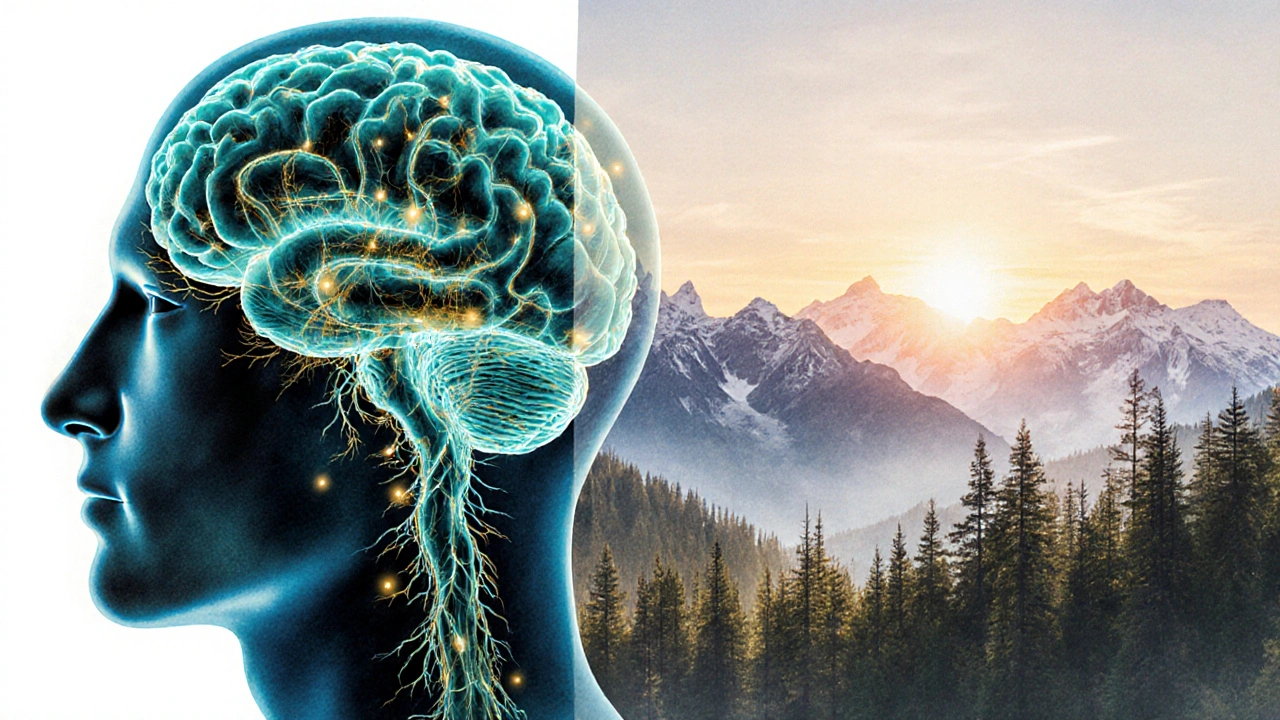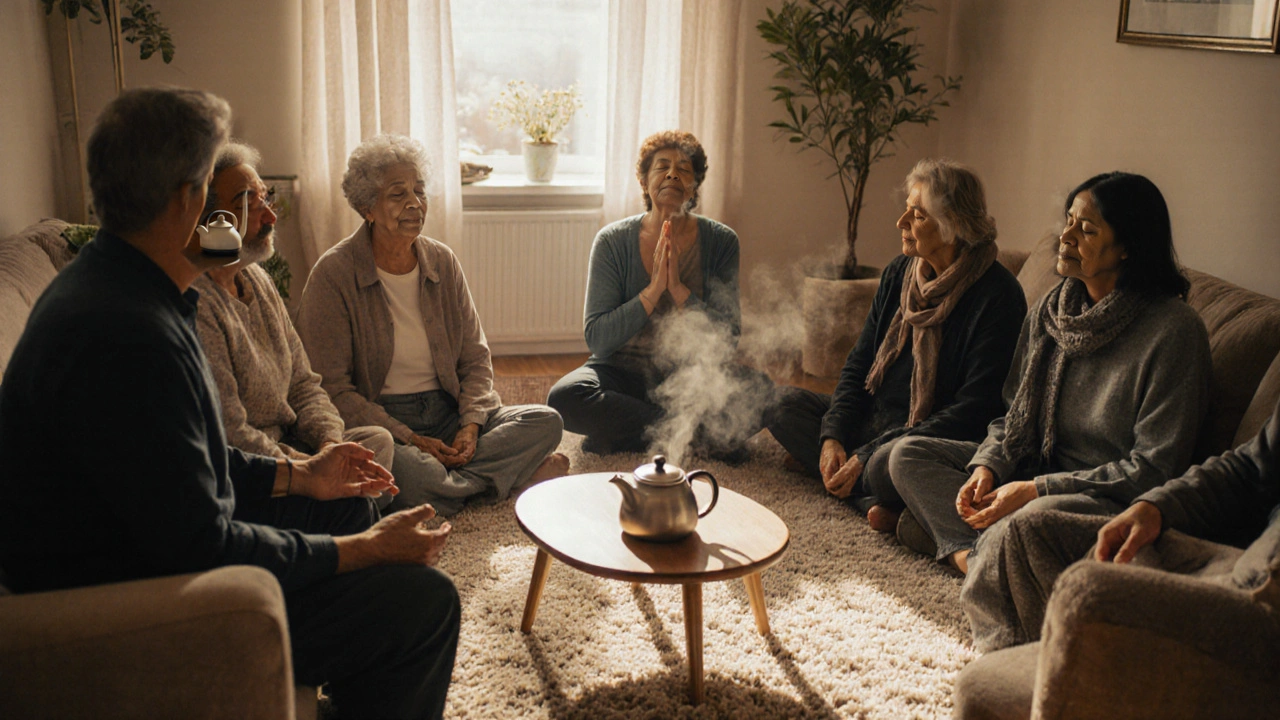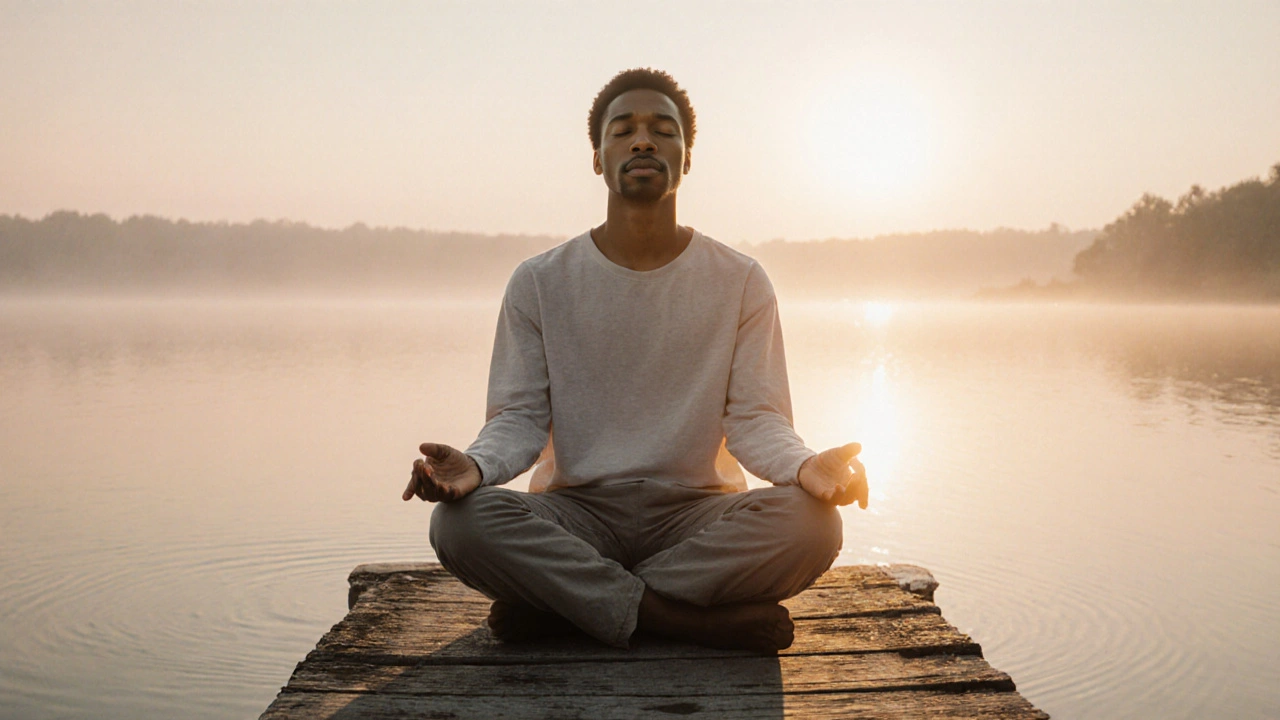Mindfulness‑based intervention is a therapeutic approach that uses present‑moment awareness to help people break the cycle of Alcohol Dependence Syndrome (ADS). By training attention, emotion regulation, and self‑compassion, MBIs create a mental environment where cravings lose their grip.
Understanding Alcohol Dependence Syndrome
Alcohol Dependence Syndrome, classified in the ICD‑11 as a chronic brain disorder, involves physical tolerance, withdrawal, and compulsive drinking despite harm. Over 18% of Australian adults report risky drinking patterns, and for many the condition spirals into a full‑blown dependence that reshapes neural reward circuits.
Why Mindfulness and Meditation Matter
Two core entities underpin the recovery boost: Mindfulness is a mental state of non‑judgmental, open awareness of present experiences, and Meditation is a set of practices that cultivate that state through focused attention, breath work, or body scanning. While mindfulness describes the outcome, meditation describes the method.
Neuroscience shows that regular practice can reverse neuroplastic changes caused by chronic alcohol. In a 2023 Australian study, participants who meditated 20minutes a day for eight weeks displayed a 12% reduction in amygdala reactivity to alcohol cues, directly lowering cravings.
Key Mechanisms in the Brain
- Neuroplasticity is the brain’s ability to reorganize connections; mindfulness enhances it, allowing new, healthier pathways to replace addiction‑driven ones.
- Stress reduction lowers cortisol levels, which are known to trigger relapse. A meta‑analysis of 45 trials found a 30% drop in self‑reported stress after an eight‑week mindfulness program.
- Craving attenuation occurs because mindful attention creates a space between trigger and response, breaking the automatic urge to drink.
Practical Mindfulness Tools for Recovery
Below are three low‑threshold techniques that fit easily into a busy life:
- Breath awareness - Sit comfortably, inhale for four counts, exhale for six. Notice the sensation of air entering the nostrils. When thoughts about drinking arise, label them “thinking” and return to the breath.
- Body scan - Starting at the toes, progressively shift attention upward, noting tension or relaxation. This helps spot early stress signs that often precede a drink.
- Three‑minute gratitude pause - Write down three things you appreciate each night. Gratitude counters the shame cycle that fuels hidden drinking.
Consistent use of these tools builds the mental muscle needed for long‑term sobriety.
Integrating Meditation into Daily Routines
For many recovering adults, the biggest barrier is time. Here’s a realistic schedule:
- Morning: 5‑minute mindful breathing while brushing teeth.
- Commute: Listen to a 10‑minute guided meditation on a phone app.
- Evening: 15‑minute body‑scan before bed.
Research from the University of Melbourne (2022) reported that participants who embedded these micro‑sessions saw a 22% increase in abstinence rates at three months compared with a control group.

Comparison: Mindfulness‑Based Relapse Prevention vs Traditional 12‑Step
| Aspect | Mindfulness‑Based Relapse Prevention (MBRP) | Traditional 12‑Step |
|---|---|---|
| Core focus | Present‑moment awareness and acceptance | Spiritual surrender and peer support |
| Session length | 8 weekly 2‑hour groups + daily home practice | Weekly 90‑minute meetings |
| Evidence base | Randomized trials show 15‑20% higher abstinence at 6months | Long‑term effectiveness varies; relapse rates 40‑60% |
| Skill acquisition | Explicit training in attention, emotion regulation | Implicit learning through storytelling |
| Adaptability | Works for secular, religious, or mixed groups | Strong spiritual framing may deter some |
Both pathways can complement each other; many clinics now offer a hybrid model that blends peer fellowship with mindfulness skill‑building.
Connected Topics Worth Exploring
Mindfulness does not operate in isolation. It interacts with several related concepts that deepen recovery outcomes:
- Cognitive Behavioral Therapy (CBT) provides structured thought‑challenging that aligns well with mindful observation.
- Nutrition counseling restores the gut‑brain axis, which can be destabilized by chronic alcohol use.
- Physical activity releases endorphins, reducing the reward gap that alcohol previously filled.
Future readers might dive into "Mindfulness for Anxiety" or "Neurobiology of Addiction" to broaden their toolkit.
Common Pitfalls and How to Avoid Them
Even the best‑intentioned practitioner can stumble:
- Over‑expecting instant calm - Mindfulness is a skill; early sessions can feel uncomfortable. Keep a log of mood shifts to spot gradual improvement.
- Skipping home practice - The 20‑minute daily dose is where change happens. Set a phone reminder and treat it like a medication.
- Relying on meditation alone - Combine with medical support, counseling, and community groups for a robust safety net.
Measuring Progress
Use simple, objective markers:
- Craving rating (0‑10) before and after each meditation session.
- Weekly alcohol‑free days logged on a recovery app.
- Stress questionnaire (e.g., Perceived Stress Scale) every month.
When these numbers trend downward, your brain is rewiring in a healthier direction.
Next Steps for Readers
If you’re ready to try mindfulness, start with a free guided meditation on a reputable platform and pair it with a brief journal entry about any urges you notice. Consider joining a local MBRP group - many Australian hospitals now run weekly sessions.
Remember, the journey is personal. mindfulness alcohol recovery isn’t a magic bullet, but it’s a proven, low‑cost ally that can tilt the odds decisively in your favor.

Frequently Asked Questions
Can mindfulness replace medication for alcohol dependence?
No. Mindfulness works best as a complementary practice. Medications like naltrexone or acamprosate address physiological cravings, while mindfulness tackles the psychological and emotional triggers.
How long before I notice a reduction in cravings?
Most people report a measurable drop after 2‑4 weeks of daily practice. The exact timeline varies with severity of dependence and consistency of meditation.
Do I need a spiritual belief to practice mindfulness?
No. Modern mindfulness is secular and evidence‑based. The focus is on attention and acceptance, not on any religious doctrine.
Is there a risk of meditation triggering anxiety?
A small minority experience heightened anxiety during early sessions. Starting with short, guided practices and gradually increasing length can mitigate this effect.
What’s the difference between mindfulness and meditation?
Mindfulness is the state of present‑moment awareness; meditation is the set of techniques used to cultivate that state. Think of mindfulness as the goal and meditation as the training method.
Can I combine mindfulness with a 12‑step program?
Absolutely. Many recovery centers run hybrid models where participants attend 12‑step meetings and also practice mindfulness in separate group sessions. The two approaches reinforce each other.
Where can I find a qualified mindfulness instructor in Australia?
Look for instructors certified by the Australian Mindfulness Association or those listed on university health services. Many hospitals now list MBRP programs on their websites.


Comments (19)
i feel kinda hopeful about trying breath work.
Wow, another miracle cure that costs nothing-because definitely we’ve all got ten spare minutes to sit still and not drink.
Listen, the whole “mindfulness fixes everything” narrative is a slick marketing spin that pretends spirituality is a free drug 🍃.
It pretends we can simply “be present” and magically the cravings evaporate, ignoring the gritty neurobiology of addiction.
First, you need to recognize that alcohol rewires the reward circuitry, and no amount of gentle breathing will instantly rewire a brain that has been hammered for years.
Second, the studies cited often have tiny sample sizes and self‑report biases that make the results look prettier than reality.
Third, the practice demands discipline; you can’t just slap on a five‑minute session and expect a miracle.
Fourth, for many, sitting still brings up the very thoughts and emotions they were trying to escape, fueling more anxiety.
Fifth, the “non‑judgmental” stance can become an excuse for complacency, as if acknowledging desire without action solves the problem.
Sixth, the commercialization of mindfulness apps leads to a subscription model that profits from vulnerable people.
Seventh, the language of “neuroplasticity” is co‑opted to sound scientific while lacking robust longitudinal data.
Eighth, real recovery often requires medication, counseling, and community support, not just solitary meditation.
Ninth, mindfulness can be a useful tool, but it must be integrated into a comprehensive treatment plan, not marketed as a stand‑alone miracle.
Tenth, the cultural appropriation of Buddhist practices without context can dilute the depth of the teachings.
Eleventh, the promise of “stress reduction” ignores that stress is a complex physiological response that isn’t solved by a few breaths.
Twelfth, practitioners need proper guidance, otherwise they risk deepening dissociation.
Thirteenth, the data showing a 12% reduction in amygdala reactivity is interesting but still modest.
Fourteenth, if you truly want to help people, push for funding of integrated programs that combine evidence‑based medicine with mindfulness, not just hype the buzzword.
Fifteenth, remember that every individual’s journey is unique, and a one‑size‑fits‑all mantra does more harm than good.
Sixteenth, so before you sell the dream, ask yourself if you’re offering a tool or a placebo disguised as enlightenment.
Hey, that breakdown of the breath‑aware exercise is spot on – I’ve been using the 4‑6 count during my morning coffee and it actually pulls me out of the automatic urge to reach for a drink.
Just a heads‑up, “amygdala reactivity” should be pluralized as “amygdala reactivities” when referring to multiple measurements, but the point still stands.
So you think a two‑hour group session and a handful of guided breaths can out‑perform decades of community support it seems almost quaint.
This article lists tables and percentages like a sales brochure for a miracle product.
One can read about neuroplasticity and feel enlightened while ignoring the messy human side of withdrawal.
The comparison table reads like a checkbox comparison for a gadget rather than a nuanced lives.
The tone suggests that mindfulness is a universal panacea with no caveats.
Readers are left to wonder whether the authors have ever struggled with a craving themselves.
In reality the best recovery plans are messy, messy, messy.
But hey keep the optimism coming it does make for a nice blog post.
Whoa, this is exactly the kind of real‑talk we need! 🌟 Imagine breathing in confidence and exhaling doubt every single day – that’s the power of a simple pause. If you keep at it, those cravings lose their grip like an old sweater falling off a chair. You’ve got the science on your side and a community cheering you on. Let’s smash those urges together and celebrate each sober sunrise!
Dude the mindfullness thing is like a kaleidoscope of calm that paints your brain in rainbow colors while the booze tries to throw a blackout.
The phrase “mindfulness alcohol recovery” should be hyphenated as “mindfulness‑alcohol‑recovery” to correctly form a compound modifier; otherwise the meaning can be ambiguous.
Great summary!! 🎉, I love how you broke down the breath‑awareness step!!, keep it up!!, this is super helpful for anyone starting out!! 😊
Thanks for sharing these practical tips – they feel doable even on a hectic schedule.
Honestly, the three‑minute gratitude pause is a game‑changer 😄. I started writing three things before bed and caught myself noticing the urge to drink melt away. It’s tiny but mighty, and it fits right into my night routine.
One must acknowledge that the reductionist portrayal of mindfulness within the framework of addiction treatment borders on intellectual complacency; true enlightenment demands a synthesis of phenomenological rigor and ontological depth that this cursory overview fails to provide.
Absolutely love this! 🎈 The micro‑sessions during brushing teeth and commuting are brilliant – they turn ordinary moments into powerful practice. Keep spreading the positivity!! 😊
While the article is informative, it repeatedly misspells “meditation” as “meditaion”, which undermines its credibility.
Hey folks, if anyone knows a good local MBRP group in Sydney, drop the link – would love to join and share experiences.
In the quiet of breath we confront the abyss of desire, and only by witnessing it can we hope to transcend the self‑imposed shackles of addiction.
What a profound exploration of the mind‑body nexus! 🌌, the data points illuminate how patience and presence reshape neural pathways, and the practical steps make the theory tangible, keep the wisdom coming!!! 😊
Sure, because adding another “mindfulness” label solves everything – next we’ll prescribe yoga for heart disease, right?